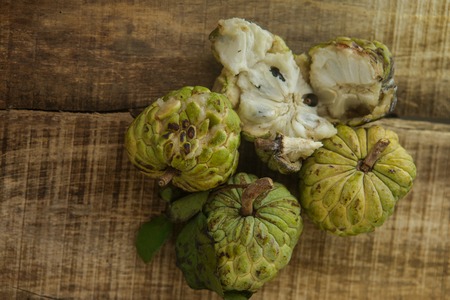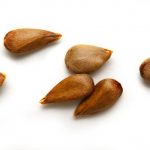
The Sugar Apple (Annona squamosa L.) is related to Cherimoya, another custard apple species. It is extremely popular throughout the tropics, especially in climates where the cherimoya can not be grown. The fruit probably originated from the Central American forests such as Honduras or Costa Rica and the West Indies. It is grown commercially in Asia, the Caribbean Basin and the Indian Ocean.
The tree produces a small (2-4″), knobbly fruit with soft, creamy white flesh often having a custard, slightly pungent and minty flavour. The fruit has a green skin but dark red varieties are now coming to market.
The fruit comes from a small, deciduous tree reaching 15-25ft. in height and spreading to the same size. Being deciduous, it loses its leaves (6-8″ long) in the winter for only 4-6 weeks. Flowers appear with new leaf growth in early spring. Fruits ripen 3-4 months later throughout summer and fall. The tree is hardy to 27°F which means it will not withstand frosts.
Propagation And Cultivation
Best grown from seed which comes to fruit bearing age in just 2-3 years. Superior varieties are propagated via budding and grafting to sugar apple or other Annona rootstock. It grows in most soils requires full sun. Sugar apples make excellent container specimens.
Uses
Usually eaten fresh or used to make smoothies, beverages and shakes.
Toxicity Issues With Consumption Of Annona Fruit
The fruit is associated with some toxicity issues if not treated well and consumption mkight be associated with neurodegenerative conditions. Annonaceous acetogenins (AAGs) are neurotoxins found in most Annona fruit and are possibly responsible for atypical Parkinsonism/dementia clusters (Bonneau et al., 2012). They are inhibitors of the first complex in the mitochondrial respiratory chain and are proposed as environmental neurotoxins responsible for Guadeloupean atypical Parkinsonism. Qualitative analysis indicated the presence of aquamocin specifically in A. squamosa fruit which was quantified using HPLC-UV (High Pressure Liquid Chromatography – Ultraviolet detection). Amounts of between 13.5–36.4 mg/fruit were measured. Further analysis using HPLC-ESI-Q-TOF and LC-MS/MS revealed 25 different AAGs including bullatacin (rolliniastatin-2) and annonacin.

Leave a Reply